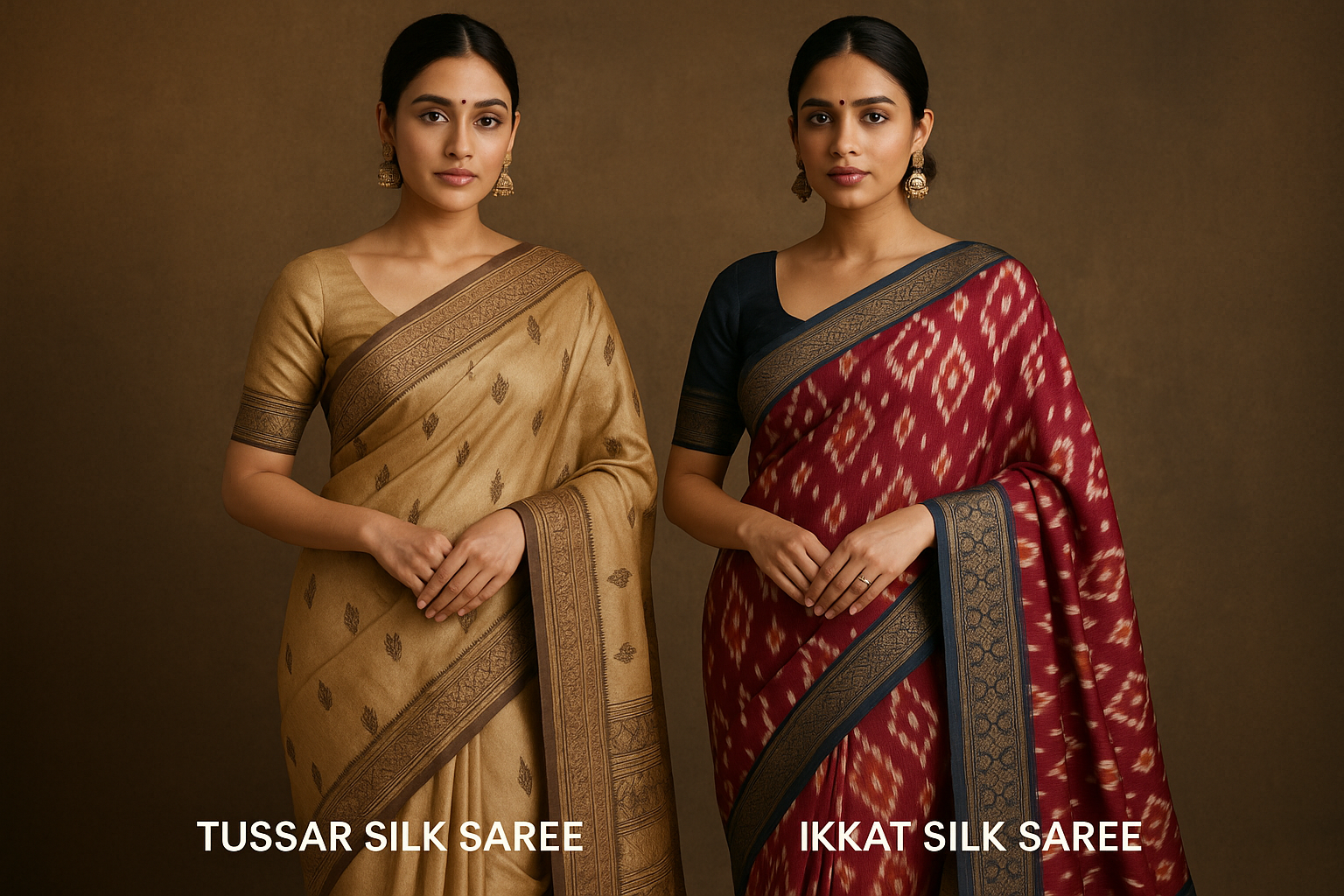Among the many expressions of India’s textile heritage, Tussar Silk Sarees stand out for their organic texture and understated charm. Woven from silk produced by wild silkworms, these sarees are known for their natural golden hues, rustic appeal, and earthy tones. The slightly coarse texture of the fabric, combined with its innate sheen, lends a unique identity that distinguishes it from more polished silk variants. Often adorned with minimalistic motifs or tribal art-inspired patterns, the design aesthetic of these sarees celebrates the raw beauty of nature and the intricacy of handcrafted artistry.
The Beauty of Simplicity in Design
Minimalism lies at the heart of the aesthetic appeal of this traditional weave. Unlike overly ornate styles, these sarees often focus on texture, subtle patterning, and a play of muted shades. The design language leans towards balance—between elegance and restraint, tradition and utility. Borders are often finely detailed yet unobtrusive, allowing the fabric itself to speak. Motifs such as leaves, vines, peacocks, and geometric forms are common, sometimes rendered in kantha-style embroidery or subtle block printing. The elegance is not in excess but in the thoughtful composition of pattern and fabric.
Palette and Symbolism
The natural shade of the silk is a soft gold, but it takes dye beautifully, resulting in rich jewel tones, warm ochres, forest greens, and deep reds. These colors are often chosen to reflect seasonal moods or ceremonial relevance. The palette complements the weave’s organic texture, allowing it to retain its depth even when richly dyed. Symbolism also plays a role—many patterns represent prosperity, harmony, and feminine grace. Despite the simplicity of the motifs, their placement and repetition evoke a rhythm that adds depth and meaning to the design.
Handcrafted Detailing and Finishing
Every saree in this category is the product of extensive manual effort. From the spinning of the yarn to the final weave, each step requires precision and skill. The weaving techniques emphasize texture and tightness, ensuring durability while preserving fluidity in drape. Finishing touches may include hand painting, delicate embroidery, or the use of naturally dyed threads for an eco-friendly aesthetic. Often, the pallu or end-piece of the saree is given special attention, featuring enhanced detailing or color contrasts to complete the look with visual drama.
Regional Styles and Variations
While the raw silk remains consistent, the regional adaptations of these sarees vary based on local weaving traditions. Some focus on tribal artistry, while others integrate temple border motifs or incorporate local dyeing techniques. This regional diversity enhances the saree’s identity, offering a spectrum of designs that appeal to both traditional and modern sensibilities. The looms are often family-run, and the techniques are handed down through generations, contributing to the continuity and preservation of unique regional expressions.
Transitioning to Ikkat Silk Sarees
Midway through the landscape of Indian weaving, Ikkat Silk Sarees emerge with their dynamic patterns and vibrant hues. Unlike surface decoration techniques, these sarees are designed using a complex resist dyeing method applied to the yarns before weaving. The result is a distinctive blurred-edge motif, achieved through meticulous planning and extraordinary craftsmanship. The visual style is instantly recognizable—bold, rhythmic, and geometric. These sarees often use vibrant color combinations and intricate patterning that give them a lively, expressive character.
The Language of Patterns
The core of ikkat aesthetics lies in its pre-determined motifs, carefully mapped out and dyed into the yarn before weaving begins. This requires immense accuracy, as any misalignment can disrupt the pattern entirely. The motifs in these sarees often reflect nature, mythology, and symmetry—featuring elements like elephants, flowers, diamonds, and abstract shapes. The design process is almost mathematical in precision but creative in execution, allowing artisans to experiment with bold and contrasting compositions. The slight diffusion of colors at the edges of patterns adds softness to otherwise sharp motifs.
Aesthetic Balance and Versatility
These sarees strike a balance between tradition and innovation. While the motifs are rooted in heritage, the combinations of color and form offer contemporary appeal. Whether worn at festivals, formal occasions, or even as statement pieces in modern wardrobes, these sarees lend themselves to versatility. Their visual dynamism makes them especially popular among those who appreciate handcrafted fashion with a distinctive flair. The boldness of the design is often balanced by the fluidity of the silk, creating a harmonious interplay of structure and softness.
Technique as Design
In these sarees, the technique itself becomes the aesthetic. The labor-intensive dyeing and weaving process adds to their allure. The repeated patterns carry with them the story of calculated craftsmanship and creative vision. Because each saree must be plotted before a single thread is dyed, the design is as much about forethought as it is about artistry. The entire process reflects a deep understanding of geometry, proportion, and movement, making every piece a wearable work of art.
Timeless Relevance in Contemporary Fashion
While rooted in tradition, both types of silk sarees continue to remain relevant in modern fashion. Designers and saree lovers alike are increasingly gravitating toward handcrafted, sustainable textiles that tell a story. Whether chosen for their earthy elegance or for their intricate visual impact, these sarees represent more than just style—they represent heritage, intentionality, and cultural continuity. As trends evolve, the design aesthetics of these handwoven wonders continue to inspire reinterpretations while maintaining their core identity.
Conclusion
The visual and textural appeal of these heritage sarees lies not only in their beauty but in their story—the labor, culture, and artistry woven into every thread. From the rustic charm and minimalist grace of one tradition to the precision-dyed, vibrant geometry of another, these sarees showcase the incredible breadth of Indian textile design. As the world increasingly values authenticity and handcraft, these timeless weaves stand as testaments to a rich legacy of design excellence.



